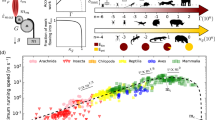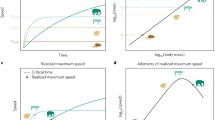Abstract
Several of the known scaling laws in the animal kingdom are based on a so-called allometric correlation in which some physical quantity is presumed to scale as some power of the mass of the animal. Such a simple correlation, when deduced purely as an empirical result, often hides the physical balances that fix the relevant scaling law. In particular, the emphasis on a simple allometric scaling has often masked the fundamental role played by time scales associated with the physical balances being struck. In this paper I have concentrated on three different attributes to which the use of dimensional analysis, scaling arguments and some judicious guesswork have led to new results and an understanding of some balances that occur in the animal kingdom.
The running speed of animals is examined and a rationale deduced for the resolution of a conundrum first posed by A.V. Hill of why it is that many animals appear to have approximately the same maximum speed. A complete dimensional analysis for scaling the basal metabolic rate for a class of animals suggests that a detailed understanding of the physical balances that fix the metabolic rate could be quite subtle. However, the use of such an analysis has led to the discovery of a new correlation for mammals, relating the metabolic rate to the mass and the pulse rate of the animal.
At the heart of many scaling laws for animal motion is the provision of an estimate of how the skeletal structure depends on the mass of the animal. It has been known for some time that the assumption of isometry between the builds of animals is too constrictive to describe the observed scaling laws. It is shown here how to relax the isometric assumption and deduce scaling laws in good agreement with observation. Thus, it appears that the skeletal dimensions of many animals with exoskeletons are fixed by the need to support static rather than dynamical loads. The scaling laws associated with endoskeletons are more complex, apparently, though the analysis does suggest that it is dynamical loading which is decisive for the skeletal design of land mammals.
Similar content being viewed by others
Literature
Ar, A., Rahn, H. and Paganelli, C. V. 1979. The avian egg: mass and strength.Condor 81, 331.
Anderson, J. F., Rahn, H. and Prange, H. D. 1979. Scaling of supportive tissue mass.Q. Rev. Biology 54, 139.
Bainbridge, R. 1958. The speed of swimming of fish as related to size and to the frequency and amplitude of the tail beat.J. exp. Biol. 35, 109.
Benedict, F. G. 1938.Vital Energetics: A Study in Comparative Basal Metabolism. Carnegie Inst. of Washington, Washington, D.C.
Furusawa, K., Hill, A. V. and Parkinson, J. L. 1927. The dynamics of “sprint” running.Proc. R. Soc. Lond. B 102, 29.
Heusner, A. A. 1982. Energy metabolism and body size. I. Is the 0.75 mass exponent of Kleiber's equation a statistical artifact?Resp. Physiol. 48, 1.
Heusner, A. A. 1982. Energy metabolism and body size. II. Dimensional analysis and energetic non-similarity.Resp. Physiol. 48, 13.
Hill, A. V. 1950. The dimensions of animals and their muscular dynamics.Sci. Prog. 38, 209.
Keller, J. B. 1974. Mechanical aspects of athletics.Proc. 7th U.S. natn. Cong. appl. Mech. A.S.M.E., 22.
Kleiber, M. 1947. Body size and metabolic rate.Physiol. Rev. 27, 511.
Lin, C. C. and Segel, L. A. 1974.Mathematics Applied to Deterministic Problems in the Natural Sciences. Macmillan, New York.
Lighthill, M. J. 1977. Comments on Dr. Prange's paper. InScale Effects in Animal Locomotion, 182. Ed. T. J. Pedley,loc. cit..
Maynard Smith, J. 1968.Mathematical Ideas in Biology. Camb. Univ. Press.
Mazumdar, J. 1989.An Introduction to Mathematical Physiology and Biology. Aust. Math. Soc.4, Camb. Univ. Press.
Merck 1986.The Merck Veterinary Manual, 6th Edn. Rahway, N.J.
Pedley, T. J. 1977.Scale Effects in Animal Locomotion. Academic Press, London.
Schepartz, B. 1980.Dimensional Analysis in the Biomedical Sciences. Charles C. Thomas, Springfield, IL.
Schmidt-Nielsen, K. 1984.Scaling. Why is Animal Size so Important? Camb. Univ. Press.
Spector, W. S. 1956.Handbook of Biological Data. Saunders and Co. Philadelphia and London.
Author information
Authors and Affiliations
Rights and permissions
About this article
Cite this article
Pritchard, W.G. Scaling in the animal kingdom. Bltn Mathcal Biology 55, 111–129 (1993). https://doi.org/10.1007/BF02460297
Received:
Revised:
Issue Date:
DOI: https://doi.org/10.1007/BF02460297




